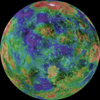

The planet Venus
|
JUNE 2006 SKYWATCH Brilliant Venus is gradually sinking lower in the morning sky as it approaches conjunction with Sun, but that will not happen until Venus and Sun converge in Scorpio, along with Mars, the last week in October. This is the same time of the final Jupiter-Saturn square, a social turning point. And it is the same time as the U.S. election, which looks to be a landslide of Scorpio’s rebirth. In the meantime, enjoy our feisty Venus as it reigns as Morning Star, announcing a new era. A must-see is splendid Venus with the delicate old moon crescent on the morning of June 22. All four of the other planets are visible in the evening. Mercury climbs high this month, the best viewing in 2006. To find Mercury, look low in the west in the fading twilight. Watch it climb higher each night, until mid-month when it reaches its peak, and heads down again. At the same time, Mars and Saturn will be very close together. Early in the month, around 10:00 p.m., Jupiter stands out in the southern sky. Follow Jupiter to the next bright star, on a shallow slope above and to the right. You’ll see Spica, the bluish Harvest Goddess. Spica is on the ecliptic, the path of the Sun and planets. Keep going. Follow the ecliptic to the next faintly bright body, orangish. You have reached Mars, fading as it moves further and further from earth. And not far beyond Mars, as you travel the ecliptic towards the northwest, is brighter Saturn. Beyond Saturn are the Twins, standing guard for mariners. On June 27, there will be a beautiful gathering of New Moon, Mars, Saturn, and Mercury all riding low in the west in evening twilight. Don’t miss it! You have now traced the ecliptic, the Sun’s great pathway. In the northern hemisphere, it is high in the winter night, and low in the summer. Its position in the daytime is opposite—high in the summer, peaking at Summer Solstice, and low in the winter, at its nadir at Winter Solstice. Sinking in the west are the great winter constellations in the Taurus area. Rising in the east is the great Summer Triangle. Right above us is that grand constellation of the northern hemisphere, the Big Dipper, with its splendid friends, Bootes the Herdsman, the Little Dipper, and Cassiopeia, the big M in the sky. Big, bright orangish Arcturus, the major star of Bootes, is right above us. This is an important star, with an extensive lore. It was a principal marker for seasons, for crops, and for sailors. You can locate it by following the handle of the Big Dipper out until you reach a very bright star. Ursa Major, or the Big Dipper, has generally been considered a sacred guardian. Sometimes it was called She Bear, the Great Goddess. But it is the Little Dipper that grabs our attention, for it contains the Pole Star, which guides us to the north. The Pole Star is truly central, for every 23 hours and 56 minutes the entire sky revolves around that center. These four minutes are why the sky looks different from month to month. The stars rise four minutes earlier every day. In a month they will be rising two hours earlier. You can find the Pole Star by using the end of the cup of the Big Dipper as a guide, and following it up until you come to a star. It is not a bright star, but it is the brightest star around. It is fun to spot that one stable star every night, and notice the different positions of the constellations circling it at different hours and on different nights. The Pole Star, or North Star, has been considered a guiding influence by peoples all over the northern hemisphere for thousands of years. Do enjoy the sky during these warmer summer nights. With familiarity you can come to recognize a star by its appearance, and they soon become old friends. |